THE EARLY HISTORY OF ELKINGTON ROAD BAPTIST CHURCH
This article is an attempt to plot the early history of what was called the ‘English Baptist Church’ in Burry Port. It uses primary sources, that is original materials produced at the time of the events being studied and providing first-hand accounts of those events. The primary sources are the minute books of the church, trust deeds and other church documentation, as well as newspaper accounts from 1894 onwards. Some local secondary sources seem to suggest quite a different view of how the church began, where it was situated and how it developed. However, the picture is incomplete due to the absence of at least one minute book but the newspaper reports go some way in explaining how the church went forward.
I would like to thank the deacons of Elkington Road Baptist Church for their generous access to the documentation and their permission to publish the remarkable story of the beginnings of the church.
The study originated in the context of the 1904 Welsh revival and its impact upon the churches of Pembrey and Burry Port. This is an ongoing research study for the Pembrey and Burry Port Heritage Group. You can read the article on the Revival at 1904 RELIGIOUS REVIVAL IN PEMBREY AND BURRY PORT – Pembrey and Burry Port Heritage | Threftadaeth Penbre a Phorth Tywyn
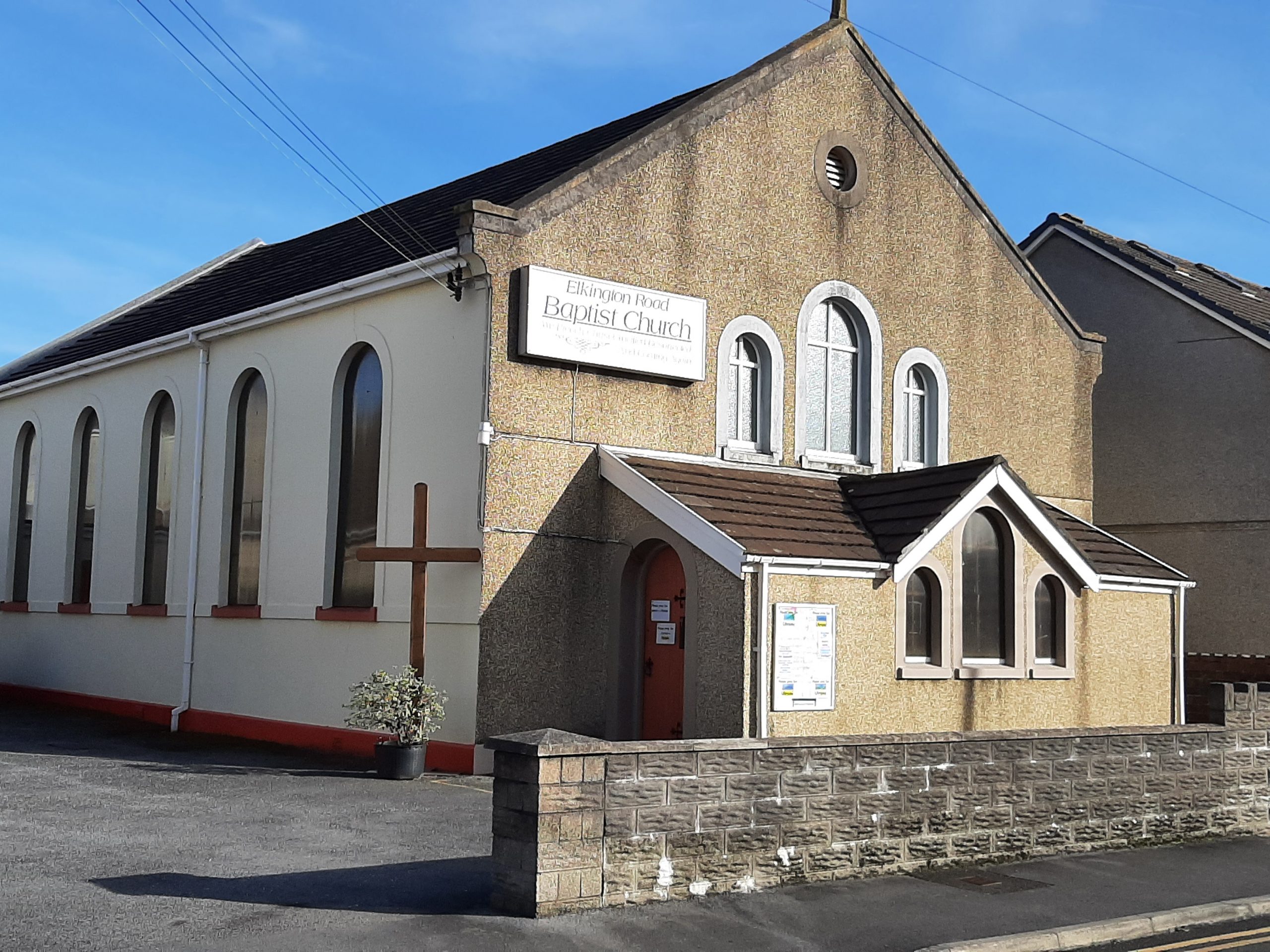
First Movements
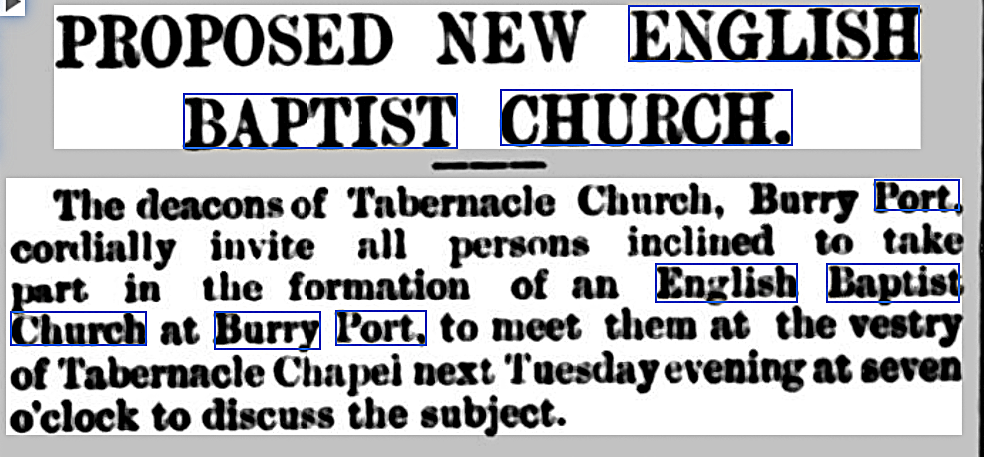 The Llanelli Mercury as early as 8th March 1894 contained the following notice: “The deacons of Tabernacle Church, Burry Port, cordially invite all persons inclined to take part in the formation of an English Baptist church at Burry Port to meet them at the vestry of Tabernacle Chapel next Tuesday evening at 7 o’clock to discuss the subject”. It is not clear what the response was but, a year later, on Tuesday morning April 23, 1895 a meeting was held at the house of Thomas Edwards in Station Road. Also present were John Wilkins (Managing Director of the White Lead Works), E. Curry, W.J. Grylls, George Reynolds and Edward Evans. At the meeting it was resolved that an English Baptist church on closed communion principles be formed and the use of the Burry Port Reading Room on the harbour be sought to hold services, or any other suitable places. The Rev E. Watkins, minister of Tabernacle Welsh Baptist Chapel in Seaview Terrace, was to be invited to the next meeting since the group was exploring the possibility of an English- speaking chapel which would be develop from the Welsh speaking Tabernacle. As a result of the influx of English-speaking people industrial workers a new chapel was needed to accommodate English language worship.
The Llanelli Mercury as early as 8th March 1894 contained the following notice: “The deacons of Tabernacle Church, Burry Port, cordially invite all persons inclined to take part in the formation of an English Baptist church at Burry Port to meet them at the vestry of Tabernacle Chapel next Tuesday evening at 7 o’clock to discuss the subject”. It is not clear what the response was but, a year later, on Tuesday morning April 23, 1895 a meeting was held at the house of Thomas Edwards in Station Road. Also present were John Wilkins (Managing Director of the White Lead Works), E. Curry, W.J. Grylls, George Reynolds and Edward Evans. At the meeting it was resolved that an English Baptist church on closed communion principles be formed and the use of the Burry Port Reading Room on the harbour be sought to hold services, or any other suitable places. The Rev E. Watkins, minister of Tabernacle Welsh Baptist Chapel in Seaview Terrace, was to be invited to the next meeting since the group was exploring the possibility of an English- speaking chapel which would be develop from the Welsh speaking Tabernacle. As a result of the influx of English-speaking people industrial workers a new chapel was needed to accommodate English language worship.
When they received a reply from the Harbour Master, John James Russell, that the reading room was not available it was proposed that an application be made to the Pembrey School Board for a rental period of six months at the new Stepney Road Infant School hall. With Isaac Phillips appointed as secretary and Thomas Edwards as treasurer and a committee of management of six others, services commenced there on Sunday May 19th. 1895. Some committee meetings often were held at the Tabernacle vestry.
Services at Stepney Road School Hall
The inauguration services were held on Sunday, June 9th with sermons at 11.00am and 2.30 pm at the school room and 6.00pm at the Tabernacle Chapel. The Rev. W.E Watkins was asked to preach a Welsh sermon but no Welsh sermon was be preached after the first Sunday. The pattern of services continued as the opening day with a Wednesday evening prayer meeting at 7.00pm. Moody and Sankey hymns were to be used. As the church developed links were made with the Glamorganshire and Carmarthenshire English Baptist Association to obtain assistance ‘for the cause’ as well as the Glamorgan and Carmarthenshire Baptist Home Mission Society. In order to facilitate the process letters of transfer were requested for 21 members from Tabernacle and Rev. W.E. Watkins responded to the request and referred to a ‘separate particular Baptist Church’ ‘praying that the richest blessings of the Most High may rest upon them’ and referring to the ‘English friends’. As a result the church was officially formed on Wednesday, July 17, 1895 at the service in which Rev. Watkins preached and administered communion.
The Church develops
Four deacons were appointed in September 1895 – John Wilkins, W.J. Grylls, Thomas Howells, Thomas Edwards; a band of hope was started meeting on Wednesdays at 6.00pm. and there are lots of examples of social and community events: for example, a lecture on behalf of the half of Dr. Bernardo’s homes; a concert – tickets were two shillings, one shilling and six pence; teas in aid of the building fund.
Finding a place of their own
Relationships with Tabernacle were good (Oct 1895) and thanks were sent to Tabernacle Church for their assistance in the ‘English Baptist cause’ by making a collection towards the ministry. The officers of the English and Welsh churches met once a fortnight. It was agreed that the church seek assistance with a view of finding a suitable building and in the meantime the church asked the school board for use of the school room for an extended period. In their resolve to find premises £12.00 were placed on deposit in the post office savings bank and it was agreed to appeal to neighbouring churches and the Home Mission Fund for assistance.
A serious move was made in April 1896 towards finding a plot of land for a chapel building and Mr. Wilkins was requested to write to the agent of his landlord asking him if he would allow him to sublease the piece of ground adjoining his house for the purpose of building a chapel. It was also agreed around this time that it would be well to appoint a pastor to the church and that some of the officers attend the Tabernacle Church meeting to find out what their views were on this matter. Assistance was to be sought from the Llanelli churches and a request for help was sought from the Baptist Union Home Mission fund (June 24, 1896). In the meantime, there were candidates for baptism and consequently a baptistry needed to be constructed. People were also being transferred into membership from churches in other areas.
Appointing a minister and other roles
The church at Tabernacle continued to support the new church and representatives of Tabernacle met with some of the church officers to discuss the best method to adopt with a view to appointing a minister. Other people were also being appointed to important roles – singing conductor, organist, children’s workers, hymn book stewards and door attenders.
In August 1896 the Rev. D.T. Richards of St. Ishmael’s Milford Haven was approached and invited to be the pastor of the church. He accepted on a salary of £70.00 per annum with the four deacons acting as guarantors for the sum. Four free Sundays in the year were to be allowed to the minister. The church was asked to contribute something towards the cost of railway carriage for Mr. Richards’s furniture from Milford Haven. The first mention of the minister being at a church meeting was signing the minutes on February 17, 1897 and it was recorded that he chaired the next one on 17th March.
A site for a new chapel
It was in October 1896 that a small group had been appointed to look out for a site upon which to build a chapel. A number of plots were considered: at Pencoed Road; adjacent to the Jubilee shop in Station Road; plots in the station field; a piece of land owned by the Pemberton estate in Ashburnham Place. It was the latter that was eventually chosen by the committee. Despite some accounts suggesting otherwise there is no evidence in the minutes available to suggest that the church had been founded anywhere other than the Stepney Road School hall.
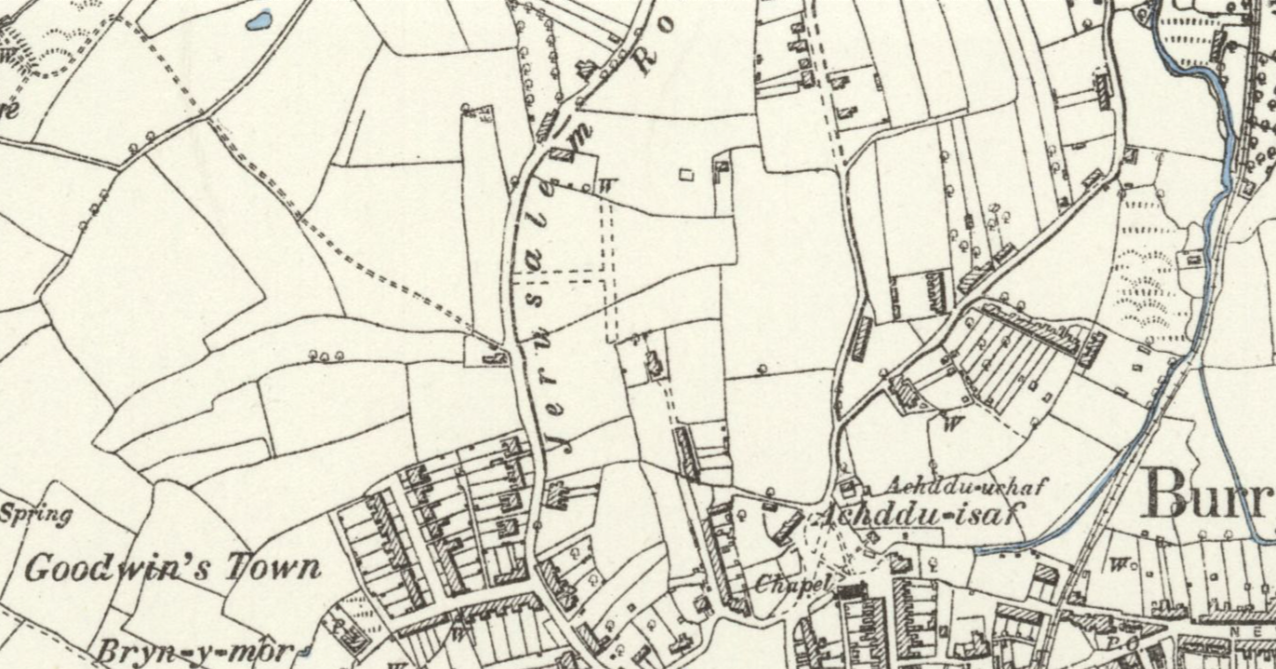
In April 1897 the proposed site offered by the agents of the Pemberton estate, known as number two plot on what was then called Jerusalem Road alongside what was described as ‘the new road to Ashburnham Place’ and in what is today Mansel Street, was accepted: 82 feet frontage, hundred feet deep, and with a lease of 99 years and ground rent £3 12s. per annum. Subscriptions were to be solicited towards the building fund and twelve collection booths set up arranged by the women of the congregation. The minister was to liaise with the ‘leading people’ of Burry Port in the collecting process. (May 19th 1897). It was suggested that the building be constructed at a cost of £450-500 and the dimensions about 40’ x 30’. An architect was to be engaged in drawing up the plan for the building. Note that a number of meetings were not able to proceed since there were no ‘Tabernacle friends’ in attendance. It is not clear if there were tensions rising between the two groups or enthusiasm had waned in the support for the new cause.
On July 14, 1897 it was resolved that tenders be invited to build an English Baptist Chapel at Burry Port in accordance with the plan and specification agreed. The tenders were to include the whole building – moveable seats, boundary wall and everything complete ‘with the key in the door’. (When a scheduled meeting to consider the report from the architect as to boundary walls and to draw up advertisements for tender, it was recorded that “not one of the Tabernacle building committee turned up”).
The plans and specifications were taken to the White Lead Company offices and laid upon the table for inspection by builders and contractors. A form of advertisement was drawn up as follows: “Tenders are invited for the erection of a school-chapel for the English Baptist church at Burry Port. Plans and specifications may be seen from 9.00am until 5.00pm at the offices of the Pembrey White Lead Works. This would be inserted in the local papers. In the next month some tenders were sent in and were considered at a meeting at the secretary’s house with a view to selection and some modifications in the specifications were suggested by Mr. George Reynolds.
The Tabernacle friends present at the 18th August meeting were authorized to say that the church was prepared to grant the sum of £50 pounds towards the building funds. It was resolved that the tenders of Mr. George Reynolds and Mr. William Smith be accepted for the masonry and carpentry work for the building of the new school chapel. Those who donated £5 pounds and upwards would have the privilege of laying a memorial stone in the chapel building.
The internal fittings are described in some detail. The idea of having chairs was abandoned in view of the price and the contract for seating in the chapel was given to Mr. Smith of Llanelly to be made in accordance with the design submitted by him – six feet benches. The windows were to be painted a hedge sparrow colour, and the hall, walls, lobby and vestry to be stucco instead of plastering. Acetylene gas was to be used and with the total cost £12 13s. 5d. The ladies to be appointed to get the linoleum and furniture. The baptistery was to be glazed bricks or tiles. South side of the chapel a section of iron railing for the front to the chapel to be made. Arrangements were to be made in appointing a person to clean the chapel. It was Anne Davies who was appointed with the requirement that the chapel should be swept and well dusted once every week and to be scrubbed out twice a year. The vestry room was to be swept and dusted and washed out once every quarter.
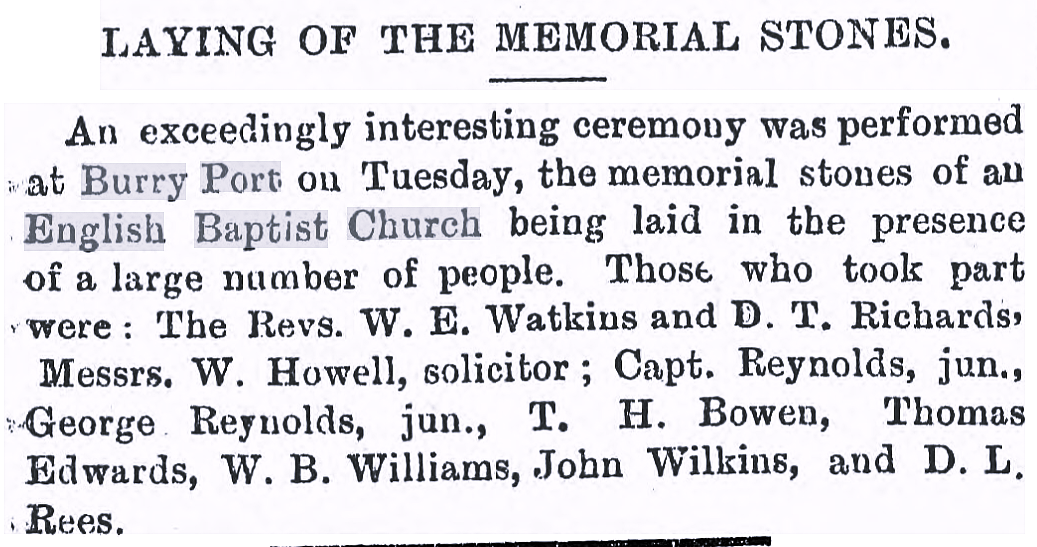 On Tuesday, November 16, 1897 It was reported that the memorial stones of the new English Baptist Chapel were laid in the presence of a large number of people. Those who took part were the Rev. W.E. Watkins (Minister of Tabernacle); Rev. D.T. Richards (Minister of Elkington Road); W Howell, solicitor; Capt. Reynolds Junior; George Reynolds Junior; T.H.Bowen; Thomas Edwards; W.B. Williams; John Wilkins and D.L. Rees. The opening services of the new chapel were scheduled for 18th March 1898.
On Tuesday, November 16, 1897 It was reported that the memorial stones of the new English Baptist Chapel were laid in the presence of a large number of people. Those who took part were the Rev. W.E. Watkins (Minister of Tabernacle); Rev. D.T. Richards (Minister of Elkington Road); W Howell, solicitor; Capt. Reynolds Junior; George Reynolds Junior; T.H.Bowen; Thomas Edwards; W.B. Williams; John Wilkins and D.L. Rees. The opening services of the new chapel were scheduled for 18th March 1898.
THE INDENTURE (31st August 1898) Original held in HSBC Bank
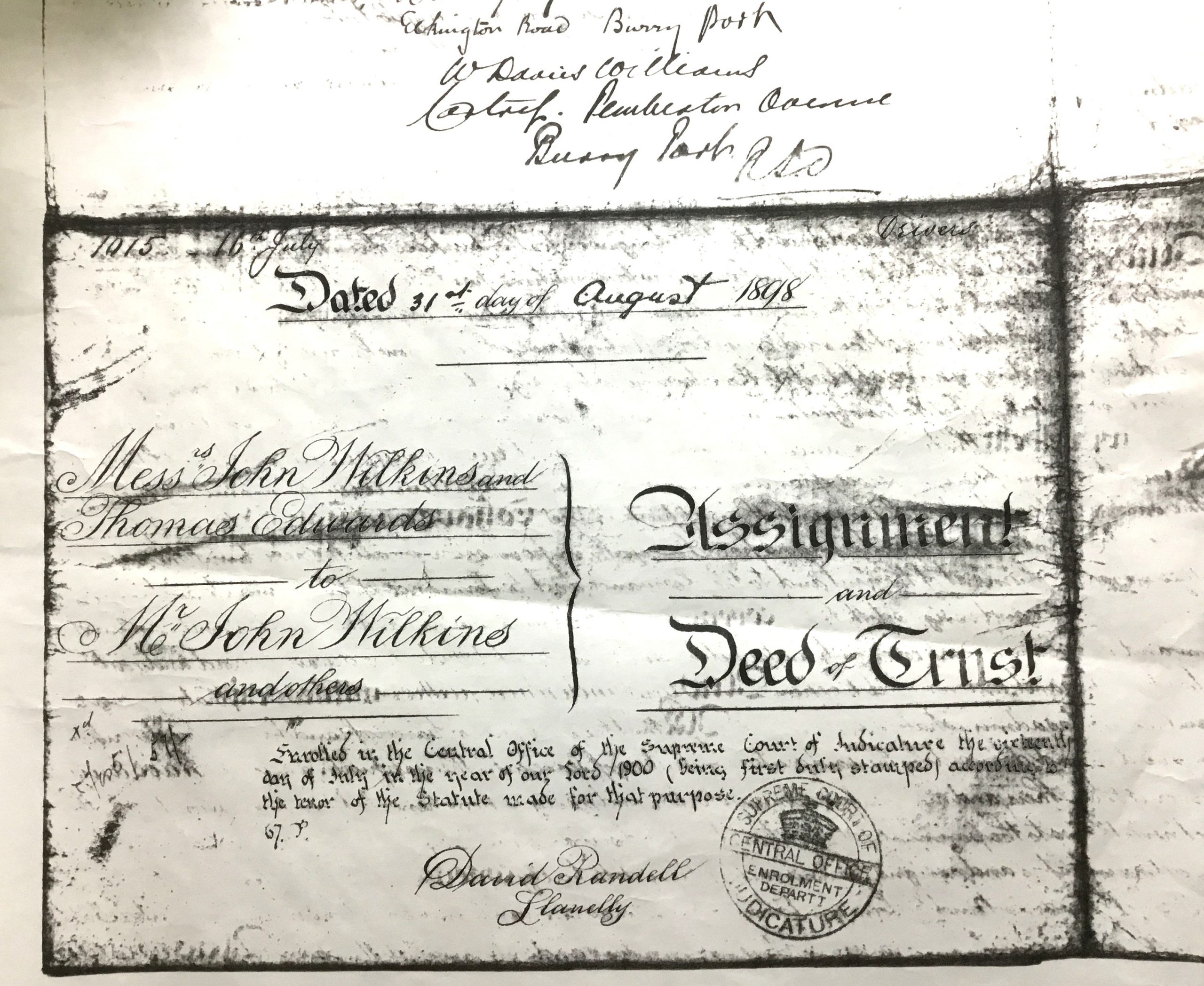 The indenture involved John Wilkins of Burton house, Burry Port, a white lead manufacture and Thomas Edwards of Station Rd., Burry Port a local merchant (called the Assignors) and David Thomas Richards, minister of the gospel; Thomas James Grenfell a plumber; Henry Phillips a tailor; Thomas Richards, retired master mariner; Rees George Reynolds a Draper; George Reynolds the younger, a builder; John Erasmus, a schoolmaster; William Davies, a master mariner; Edward Evans, an accountant; Daniel Lewis Rees, a merchant. These were trustees.
The indenture involved John Wilkins of Burton house, Burry Port, a white lead manufacture and Thomas Edwards of Station Rd., Burry Port a local merchant (called the Assignors) and David Thomas Richards, minister of the gospel; Thomas James Grenfell a plumber; Henry Phillips a tailor; Thomas Richards, retired master mariner; Rees George Reynolds a Draper; George Reynolds the younger, a builder; John Erasmus, a schoolmaster; William Davies, a master mariner; Edward Evans, an accountant; Daniel Lewis Rees, a merchant. These were trustees.
The other party was Frances Maria Sophia Pemberton who leased the land – 939 yd.² – for 99 years with the chapel and outbuildings for the use as a chapel or meeting house, members and congregation of the particular or Calvinistic Baptists known by the name the English Baptist Chapel, Burry Port. The assignors have agreed to assign the said piece of land and premises to the trustees.
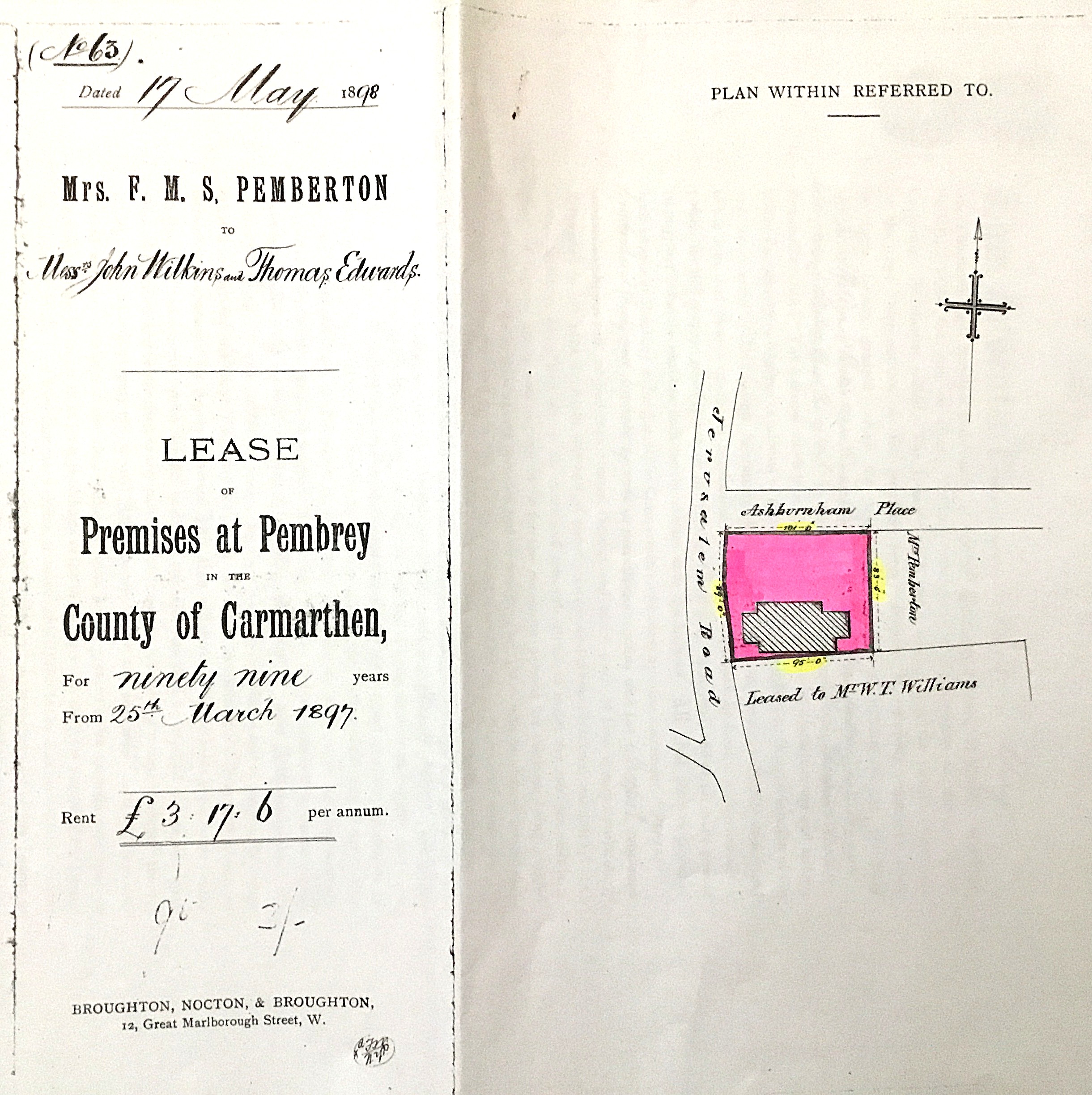
The role of the trustees is described in some detail in the theology of the Baptist cause. They will dedicate, devote and preserve the chapel for the purpose of holy and divine worship according to the tenets or articles of faith set forth in the indenture. The doctrines include the one living and true God, three equal persons in the Godhead, the proper deity and real humanity of our Lord Jesus Christ, the regeneration, conversion and sanctification of the Son of Man by the spirit and grace of God. The resurrection of the dead and future judgment of eternal happiness of the righteous and the everlasting misery of the wicked. The baptism by immersion in water in the name of the Father and the Son and of the Holy Spirit. Only those who have previously been baptized by immersion can partake of the Lord’s supper and on his or her personal profession of faith in the Lord Jesus Christ.
Permission will be given to officiate in the chapel only those of the Baptist denomination and it will be only lawful for the church to choose a pastor who maintains and teaches the doctrines mentioned and practices baptism. As long as the Tabernacle Welsh Baptist church contributes financially to the support of the English Baptist church they shall have the power to take part in the administration of the general affairs of the church. Normally decisions at the church meeting will need two thirds of the majority of men and women members present. However, it seems that some decisions relating to establishing a Sunday school, either in an additional building or in the school rooms, or changes to the use of the piece of land or chapel or repairs and alterations or sale of the premises, or replacement of the trustees are to be made by a majority of the men members.
In the original leasing indenture (17th May 1898) between Frances Maria Sophia Pemberton and John Wilkins and Thomas Edwards what was not included was all mines and minerals within or under the premises and the rights to enter and exit of agents, servants and workmen with or without horses, carts and carriages into and from the premises to work any mines and dispose of any produce making reasonable recompense to the lessees. The premises were to be kept in good and substantial repair and painting in good oil colours with two coats at least for all external parts of the wood, iron and other works throughout the premises to be painted once in every three years; the inside parts to be painted once in every seven years during the time of the lease. Any repairs to roadways, pavements, fences, party walls, sewers and drains should be shared. The ‘lessor’ would be allowed to enter the premises at reasonable times in the day to view the state and condition; permission is also to be given for entry to empty and cleanse the cesspools, gutters, sewers and drains of the premises and other houses adjacent.
The Church Dispute and Split
The first minute book which has provided most of the information up to this point ends on June 29th 1898 but the local newspapers contain many reports of a troubled time for the church which ultimately led to a split. In fact, a new church, Stepney Road Baptist Church, was established in January 1906. The story of this venture is described below.
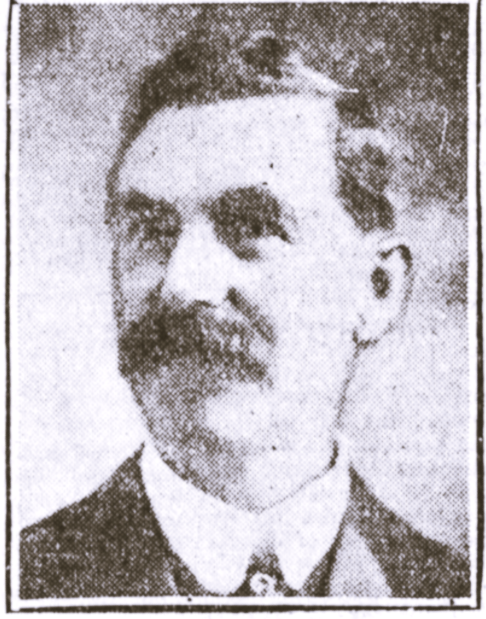
Copyright Unknown
A division developed between the pastor Rev D.T. Richards with the group who supported him and members of the church who opposed some of his behaviour and decisions. The latter seemed to be represented by some of the Trustees, with much criticism made against Arthur Morgan, John Wilkins and John Eager. On one early occasion trouble broke out resulting in a court case, reported in the South Wales Daily News (October 1902) which involved an incident at the Elkington Road Church on October 30th. Apparently, a heated discussion took place ‘about the expulsion of a member’. The complainant accused John Eager of insulting behaviour following a verbal attack by the complainant against Mrs. Eager. The case seems to indicate one of the causes of divided opinions – church discipline.
The disagreements had been an issue for a considerable time when a majority of the members decided to call a special meeting to try to deal with the issue once and for all. The pastor, Rev. D.T. Richards ‘refusing to be gagged’ addressed a meeting outside the chapel when he stated his grievances to all gathered. The meeting inside the chapel was rowdy with some members insulted as they entered and left the building. Some, who were not members, had to be ejected from the meeting by two local constables A resolution was submitted that the pastor should be given three months’ notice and out of a membership of 45, 29 voted in favour. (It was implied later by Rev. Richards that by far the greater number of the 29 either worked under or were closely related to those who worked under Mr. Morgan). The pastor declined to accept the decision and asked for an arbitration process from the Baptist Union. The outcome of that was that Rev. Richards be counselled to sever his connection with the church, the Association would withdraw its support and the new church should apply for membership of the Association through the Swansea district. (June 1905)
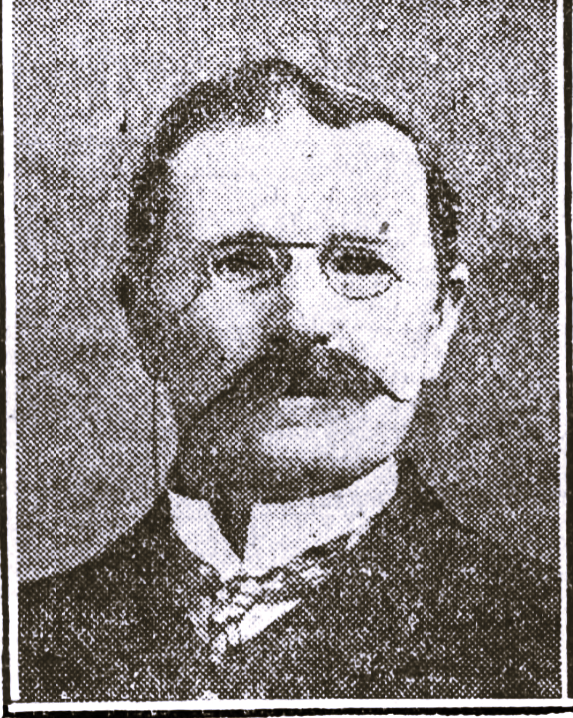
Copyright Unknown
Leaving the meeting Arthur Morgan was roughly handled and the stationmaster was struck three times with stones. Mud and soot were thrown at Mrs. Eager and she fainted and had to be carried into a house. Children and grown-ups continue to march up and down the streets singing and shouting and beating tin cans – ‘the uproar eclipsed anything in the way of disorder that Burry Port has ever experienced’.
A serious development occurred when the chapel was closed following a notice being posted by the Trustees while the pastor and his supporters assembled outside the chapel. They eventually climbed over the fence onto the green adjoining the chapel where a short service was held. In the afternoon a meeting near the railway station took place with a large crowd assembled and presided over by Dr. Williams of Snowden house. Sympathy was shown to the pastor who was described as “an inoffensive, quiet and good man”. The pastor responded with claims that he had been “persecuted for standing up for the right and trying to put down tyranny”. He did not believe in taking marching order from “over there”, pointing to the harbour. No doubt this is a reference to members of the opposition which included Arthur Morgan, harbour master, and John Wilkins, Managing Director of the White Lead Works. The impression given in a number of reports is that there was considerable tension between Arthur Morgan and some of his employees and the pastor.
When the church was reopened at the end of March 1904 those members opposed to the pastor were not present and presumably left at that point to start worship services in the council school, a move eventually leading to the development of a new church – Stepney Road Baptist.
Complaints against the pastor
In letters to the editors and some column reports these are the complaints made:
- Insulting remarks against the church at Tabernacle.
- Officers resigned because they ‘could not get along with the pastor’.
- Members cannot agree with the pastor’s methods of discipline.
- Pastor does not agree with fund-raising concerts and does nothing to help.
- Pastor makes his complaints in public since he suggests he was ‘gagged’ in the chapel.
- Pastor would not cooperate with the arbitration committee of the Baptist Association.
Complaints against Arthur Morgan (Llanelly Mercury March 10th 1904)
- At the close of the communion service Arthur Morgan called the officers of the English Baptist church “a gang of blank blank ” and then left the church in a towering rage.
- When there was a discussion concerning the lighting of the chapel he threatened to clear out if the lamps did not arrive by a certain time.
- Morgan at the close of a Sunday morning service went into the vestry and upbraided the pastor having preached a sermon on love and asked in no gentle spirit why do you not whip the people more.
- He brought a charge against ‘one of the most godly young men that ever lived in Burry Port’ for having prayed for the elders of the church that they might have grace to set the younger members a good example. Mr. Morgan shook his fist at the young man and said to him “I’ll make you suffer”.
- Morgan had a tiff with Mr. Williams the stationmaster and subsequently said that he would wring his neck for him.
- He had a telephone conversation to someone in which he said he would leave no stone unturned until he gets Rev. Richards out of the pulpit.
Stepney Road English Baptist Church, Burry Port
 The Carmarthen Weekly of October 13th 1905 reported that at a meeting of the Burry Port District Council plans for the erection of a new English Baptist church in Stepney Road were submitted and approved. In fact, the new Stepney Road Baptist Church opened in January 1906. There were a number of Sundays of services to celebrate the event. It seems that the members and congregation had been holding services at the local school and had resolved to ‘erect an iron chapel at a cost, including furnishing, organ etc. of £300’.
The Carmarthen Weekly of October 13th 1905 reported that at a meeting of the Burry Port District Council plans for the erection of a new English Baptist church in Stepney Road were submitted and approved. In fact, the new Stepney Road Baptist Church opened in January 1906. There were a number of Sundays of services to celebrate the event. It seems that the members and congregation had been holding services at the local school and had resolved to ‘erect an iron chapel at a cost, including furnishing, organ etc. of £300’.
The officers of the church were: Thomas Edwards, Rees G. Reynolds, John Eager, Rees Lewis, John Wilkins, Arthur Morgan. Edwards, Reynolds and Wilkins were trustees of the Elkington Road Baptist Church.
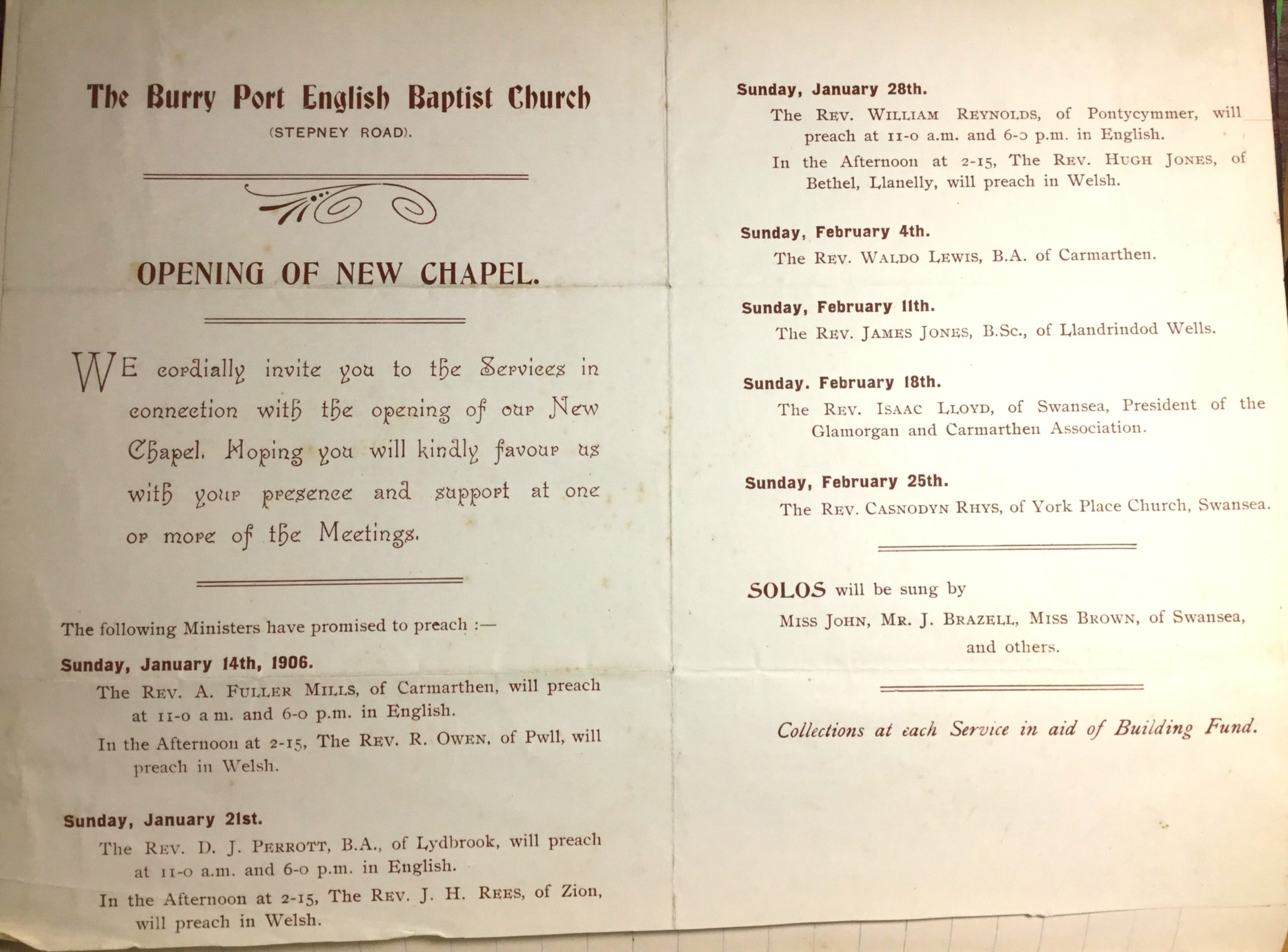 The Development of the Church
The Development of the Church
The minute book charts the development of the church and shows many similarities to the Elkington Road church. Here are some of the main features up until 1918.
- Door keeping in the church and the collection of the hymn books were important roles and those appointed are named.
- A system of seat rent was adopted at 6d a quarter and with a maximum charge of 2s. 6d. per quarter for a whole seat. Weekly envelopes were introduced.
- As early as March 1906 the church was discussing seeking a pastor.
- The church was received into the Baptist Union in June and into the Association at Cardiff in July.
- Ivor Jones was appointed choir conductor and Gwen Morgan organist.
- In February 1907 an invitation was given to the Rev. Elias Evans to be the pastor of Stepney Road church. The salary was £80 per year with 6 free Sundays during the year. The Rev. Elias Evans was a native of Monmouthshire, his father was a pastor near Aberdare and he was a descendent of an old Baptist family extending back more than 50 years.
- 28 members voted in favour of his appointment and four remaining neutral.
- Finance was a continuous issue with funds fluctuating. In November 1907 the balance was a mere £7.3s.6d. The repair of the organ by Messrs Thompson and Shackell must have been a challenge as well as the application from the caretaker, Mrs Davies, for an increase in salary. It was raised from 8s. 10s. per month.
- At the beginning of 1909 financially and numerically the church was reported to be in a favourable position with 70 members, but not all attending regularly. However, the finances were obviously a recurring issue. Repairs had to be made to the boundary wall, the front fence by the door; the doors needed painting.
- In 1910 the chapel cleaner and caretaker resigned as a result of the financial situation. In the same year the church organist resigned for a different reason – ‘it was understood that since she had married she could not be expected to continue’. She was presented with a beautiful 28 day marble clock
- An offer was accepted from Mr. Gomer Lewis to provide a lecture. 400 tickets at 1s. each to be printed and 200 at 6d. 50 posters to be printed.
The re-uniting of the two churches
On 10th May 1911 the Trustees were asked to meet Rev. D. T. Richards and Albert Taylor at the Elkington Road chapel. They were informed that the present occupiers of the chapel were unable to carry on the cause and wish to be relieved of the responsibility and liability. The result of that meeting and one later was that the Trustees took over the chapel with the existing debts then amounting to £265. Mr. Edwards was requested to communicate with the Tabernacle and Stepney Road churches to invite their views as to the course to adopt for further operations.
On 21st May the Stepney Road church meeting was held at the close of the Sunday evening service when the church and congregation thanked the trustees of the Elkington Road chapel for their communication regarding the ‘re-occupation’ of the above chapel by this church. They stated that there is at present but one English Baptist church in Burry Port and we have the prospect of soon meeting in the old building united for the English Baptist cause.
A meeting on 28th May confirmed the previous arrangement with the following resolution:
“This church desires to thank God for the prospect of re-occupying its own original home in Elkington Road chapel and accepts all financial liabilities on the building. The building was to be inspected and any necessary preparation was authorised to take place. A copy of the resolution was sent to the Tabernacle church, which indicates its continuing links, and at a meeting of the Trustees it was resolved: “that the Trustees accept such resolution and do hereby hand over possession of these premises to your church as from this date,1st June, and we pray that the future may prove prosperous and happy to all interest in the kingdom of our God and of His Christ”. The minutes of the meeting were signed by Rev Elias Evans, the minister of the Stepney Road church.
The reunion was not without its problems and one newspaper report quotes from one member feeling sorry that there is a lack of that brotherly feeling which should have been mutually displayed by both parties. There were some “sticklers for apologies and retractions in the church”.
Some interesting features and developments up to 1918
The church authorized the secretary to get a loan of 50 pounds from Lloyd’s bank for six months. A promissory note was signed by nine of the members. The purpose was reported to enable them to pay off the debt of the previous occupiers and to renovate the chapel both inside and outside.
- The payment of £80.00 pounds per year salary for the pastor was terminated and at the end of nine months from the date named he agreed to accept what the church could find after payment of all the expenses.
- The need for a cemetery was discussed.
- In April 1912 the secretary explained and submitted particulars of the sale of Stepney Road chapel for the sum of £180.
- The church’s area was to be divided into districts and each deacon was expected to look after the members in his district by occasional visits.
- Arrangements were to be made to get the chapel registered for the solemnization of marriages and this was achieved in 1913.
- From March 1913 the church became an open communion.
- An organ was bought for £10 from Thompson and Shackell, and the ‘red organ’ was given in exchange with an allowance of £3.30s.
- A suitable cloth to be provided for covering the elements before communion. A wooden boundary fence was obtained and subscriptions asked from the members.
- A sum of two guineas was presented to the organist in recognition of his services on his leaving to join the Army.
- In May 1915 the treasurer reported that the balance in hand at present was £2.00 over liabilities.
- In December 1916 brother Collins was unable to attend because of his working every Sunday on munitions. He has the welfare of the church at heart and hopes to attend better after the war.
- In a special church meeting on December 17th 1916 it was resolved to give a call to the reverent D.J. Thomas of Treherbert to become the pastor of this church. The call was accepted and Mr. Thomas commenced his ministry on Sunday, February 14th 1917 ‘under very favourable circumstances’.
- In January 1917 in order to raise funds the church adopted the weekly system of a penny or more per week and some of the women were appointed to undertake the collecting.
- The pastor was allowed to have the plot of ground at the chapel for the purpose of cultivation free of all charge.
- In March 1917 the balance in hand was £19.6s.1d.
- In July 1917 the wages of the chapel keeper were raised from 12s. to 15s. per month.
- In October 1918 a further instalment of £25.00 had been paid towards reducing the debt on the church. The proceeds of the sale of produce from the Thanksgiving Service were given to the local soldiers and sailors comforts fund.
- November 1918 – Owing to the pastor leaving for France a new superintendent was required for the Band of Hope. The pastor was given a gift of £5.00 from the church funds. Next month a letter was read from the pastor notifying the church of his safe arrival in France and inquiring about its welfare.
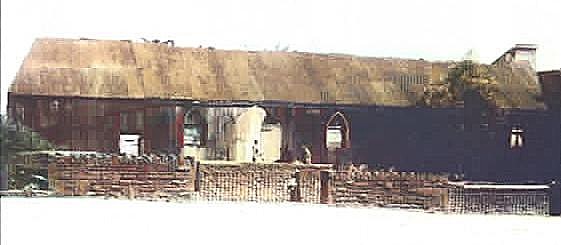
GRAHAM DAVIES September 2025
